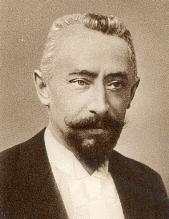Edmond Nocard facts for kids
Edmond Isidore Etienne Nocard (born January 29, 1850 – died August 2, 1903) was a French veterinarian and microbiologist. He was born in Provins, France. A microbiologist is a scientist who studies very tiny living things like bacteria and viruses. Nocard made important discoveries about diseases in animals and humans.
Contents
Becoming a Veterinarian
Edmond Nocard studied to become a veterinarian from 1868 to 1873 at the École Vétérinaire de Maisons-Alfort, a famous veterinary school in France. After finishing his studies, he worked at the same school. From 1873 to 1878, he was in charge of the clinical services, helping sick animals.
In 1876, he helped start a new science magazine called Archives Vétérinaires. He wrote many articles for this magazine about animal medicine, surgery, and health. In 1878, he became a professor at the veterinary school. One of his students, Camille Guérin, later became famous for helping to discover the BCG vaccine, which is used against tuberculosis.
Working with Louis Pasteur
In 1880, Nocard joined the laboratory of the famous scientist Louis Pasteur in Paris. Pasteur is known for his work on vaccines and pasteurization. Nocard worked with Pasteur and another scientist, Emile Roux. They did important experiments on vaccinating animals against a serious disease called anthrax.
In 1883, Nocard traveled to Egypt with other scientists to study an outbreak of cholera. They tried to find the germ causing the disease, but they couldn't.
Discoveries in Bacteriology
When Nocard returned to the veterinary school in Alfort, he set up his own research lab. He was very skilled in the new science of bacteriology, which is the study of bacteria. He developed many new techniques for studying germs. For example, he found better ways to grow bacteria in the lab. He also found new ways to give anesthesia to large animals for surgery.
Nocard's hard work paid off. In 1887, he became the director of the veterinary school. He also became a professor of infectious diseases. In 1888, he was invited to join the first group of editors for the Annals of the Pasteur Institute, a very important science journal. He became a full member of the Pasteur Institute in 1895.
From 1892 to 1896, Nocard worked hard to show people that a substance called tuberculin, discovered by Robert Koch, could help prevent bovine tuberculosis in cows. He wrote a famous book about this, explaining the dangers of bovine tuberculosis and how it relates to human tuberculosis.
Nocardia Bacteria
One of Nocard's most important contributions was discovering a new type of bacteria. This group of bacteria was later named Nocardia in his honor. These bacteria cause a disease called nocardiosis. This disease mostly affects farm animals like cows, causing a condition called bovine farcy. Nocard was the first to discover a Nocardia bacterium, which he initially called Streptothrix farcinica.
Nocardia can also cause disease in humans, especially in people whose immune systems are weak, like those with AIDS.
Other Important Work
Nocard also made other important discoveries in animal health. He found the germ that causes a common udder infection in cows called mastitis. This germ is called Streptococcus agalactiae.
He also discovered the virus that causes a serious lung disease in cows called bovine peripneumonia. Nocard also studied psittacosis, a disease that can spread from birds to humans.
Edmond Nocard passed away on August 2, 1903, in Saint-Maurice, France. His work greatly helped our understanding of animal and human diseases.


